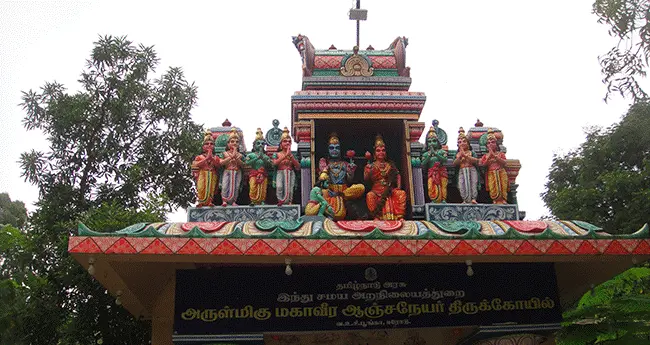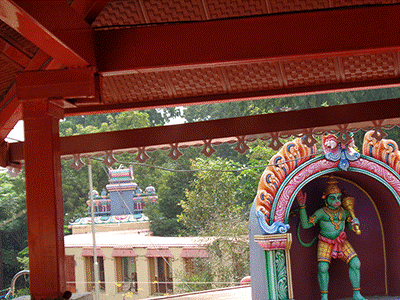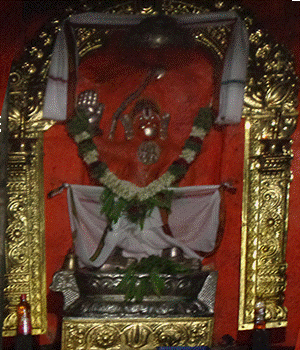
V.O.C.Park
The most popular place in Erode is the VOC Park. The location is also of great historical significance. This place was at the far end of the once existing fort. The natural rock present here acts as a protective layer for the fort. The inscription dated 1628 in VOC Park states that Chandramathi Mudaliar, the then ruler, had donated land for the construction of a ‘Chatram’.
 A drinking water project for the town was planned; it was to have four huge tanks at the highest point of town. Erode Municipality built a reservoir to store water from the river Kaveri. And four tanks in the form of towers joined with a wall were constructed. As a part of the same project, VOC Park was constructed.
A drinking water project for the town was planned; it was to have four huge tanks at the highest point of town. Erode Municipality built a reservoir to store water from the river Kaveri. And four tanks in the form of towers joined with a wall were constructed. As a part of the same project, VOC Park was constructed.
Pechiparai Rock, where this project has come up, is the tallest point in the town. The four tanks set up at the top of the rock are a scenic beauty, with artistically well-laid steps leading to the tanks. This is the center of attraction of the present-day park. At the end slope of the rock, a temple for Sri Anjaneya, and on the side of the rock, a dargah of Muslim clergy Hazrat Fasal Sha Kadiri are seen.
Pechiparai
This town has a long history and was under the rule of Cera in 850 A.D., then under Chola, Padiars, Mudurai sultanate/Nayaks, Mysore rulers, and then under the British till independence. Under Mysore’s [de facto ruler Hyder Ali] regime, this town was in a flourishing condition with 300 houses. A population of 15000, a mud fort, with a garrison of 4000 soldiers, surrounded by Coconut groves and fertile lands, bounded on the north by the River Cauvery.
During his regime, Hyder Ali donated 460 acres of land to the dargah, named after a Muslim clergy, Hazrat Fasal Sha Kadiri of Yemen, in the present town. It is also believed that his soldiers were camping where Pechiparai is presently situated.
The another version says that the influence of the ‘dvita’ philosophy professed by Sri Madhvacharya predates the arrival of the Mysore regime here. During the 17th and 18th centuries, with the sway of Shri Lakshmi Manohara Teertharu and his disciples, worship of 'prana devaru' [Sri Anjaneya] was predominantly seen here. Therefore, Sri Anjaneya should have come here during the Shri Lakshmi Manohara Teertharu period itself.
Sri Anjaneya carving on the rock
We may kindly recall the custom of the Mysore regimental soldiers wherever they are camping. The soldiers of the Mysore regiment rulers had a custom of worshiping Sri Anjaneya to draw inspiration to be brave. Wherever they camp, they make carvings or a pictorial representation of Sri Anjaneya. We invite readers to refer to our other articles, namely “Palaghat” and “Chennai”.
Here in Erode, at one end of the long-running rock Pechiparai, a carving of the Sri Anjaneya idol is there. Today, we see a temple built for this carving. While the origin of the carving is not known, it is believed that the carving could have been made while the soldiers of the Mysore rulers were staying here.
There is another version that says the influence of the ‘dvita’ philosophy professed by Sri Madhvacharya predates the arrival of the Mysore regime here. During the 17th and 18th centuries, with the sway of Shri Lakshmi Manohara Teertharu and his disciples, worship of 'prana devaru' [Sri Anjaneya] was predominantly seen here. Therefore, Sri Anjaneya should have come here during the Shri Lakshmi Manohara Teertharu period itself.
Temple for Sri Anjaneya
 As per the memories recorded by elderly people on the construction of the water tank, they say that this temple was also in existence then. Today, this temple attracts huge numbers of devotees. A neat pathway from the entrance of the park to the top of the rock has been laid. This neatly kept corridor’s walls are painted with scenes from the life of Sri Anjaneya. After climbing the steps, one arrives at the top of the rock where the Lord presides. There is a huge hall in front of the Garbhagraham, from where the devotees can have darshan of the Lord uninterrupted. There is a sannidhi for Sri Ganapati on the side. Even when there is a large number of devotees, the serene atmosphere is undisturbed, hence the darshan is pleasant.
As per the memories recorded by elderly people on the construction of the water tank, they say that this temple was also in existence then. Today, this temple attracts huge numbers of devotees. A neat pathway from the entrance of the park to the top of the rock has been laid. This neatly kept corridor’s walls are painted with scenes from the life of Sri Anjaneya. After climbing the steps, one arrives at the top of the rock where the Lord presides. There is a huge hall in front of the Garbhagraham, from where the devotees can have darshan of the Lord uninterrupted. There is a sannidhi for Sri Ganapati on the side. Even when there is a large number of devotees, the serene atmosphere is undisturbed, hence the darshan is pleasant.
Sri Anjaneya
The idol of the Lord is in embossed form on the face of the rock. The Lord, in a standing posture, is facing north. The feet of the Lord are seen ready to walk westward. The raised right hand of the Lord is showing ‘abhaya mudra’, thus bestowing His devotees the quality of ‘nir-bhayathva’. The raised tail of the Lord once again assures the devotees not to fear doing anything righteous in life. The Lord is adorned with Yagnopaveetham, kundal, and other ornaments. The eyes of the Lord are glowing with compassion and care.
Location of the temple: "Sri Mahaveera Temple, V.O.C.Park, Erode"
Experience
Darshan of Lord Mahaveera of this kshetra is bound to boost the confidence of His devotee to undertake any righteous venture without an iota of doubt.
SRI HANUMAN THINKS DIFFERENTLY, THINKS FAST
THINKS AHEAD AND ACTS FOR SURE
Ed [April 2025]



